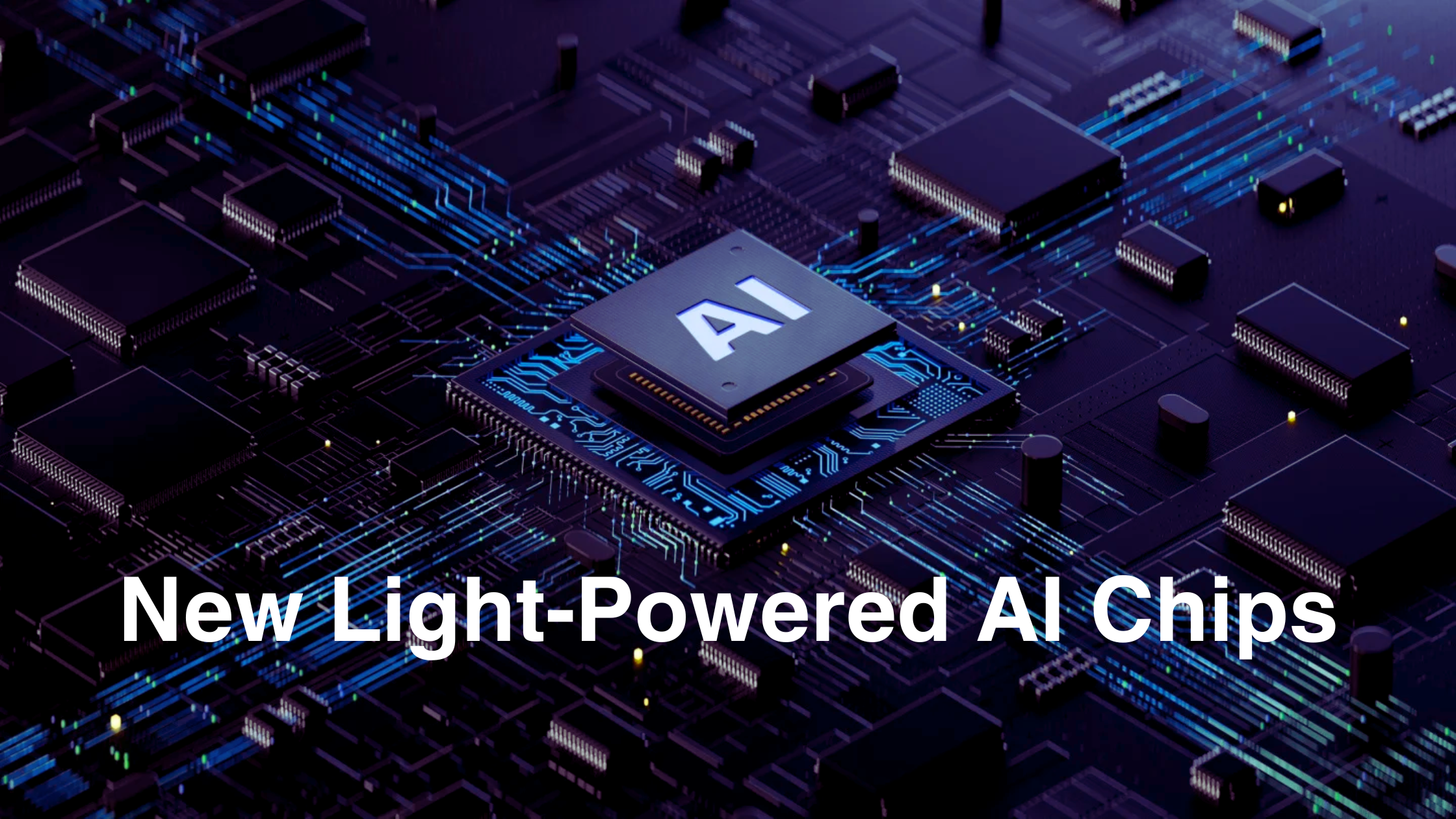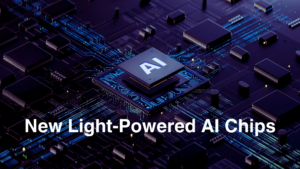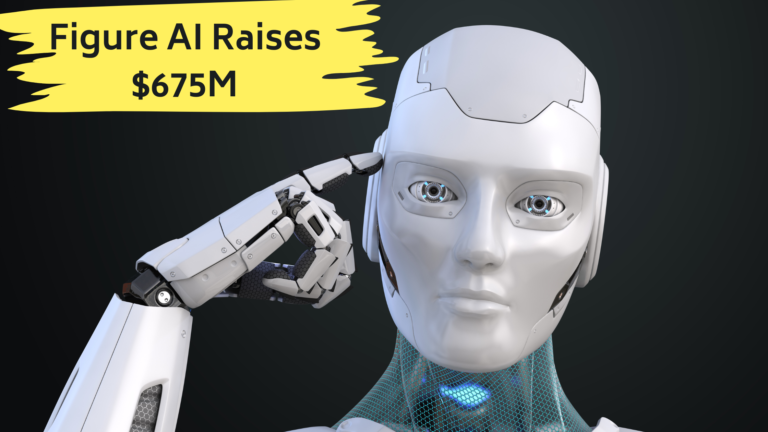New Light-Powered AI Chips Challenge NVIDIA’s Dominance
In the fiercely competitive arena of artificial intelligence (AI), a formidable contender has emerged to challenge the established dominance of NVIDIA: the advent of new light-powered AI chips.
These revolutionary chips mark a paradigm shift in computing, harnessing the potency of photons to execute computations with unprecedented speed, efficiency, and security. Unlike traditional electronic chips reliant on the movement of electrons, light-powered AI chips leverage the remarkable characteristics of light particles to propel computing capabilities to new heights.
The concept of light-powered chips revolves around utilizing photons, the fundamental units of light, to perform computational tasks. By exploiting the inherent speed of light, these chips offer the potential for significantly faster processing compared to their electronic counterparts.
Moreover, their utilization of optical technology enables enhanced energy efficiency, promising a greener and more sustainable approach to computing. This not only addresses the pressing need for eco-friendly solutions but also holds the potential to reduce operational costs associated with energy consumption.
Furthermore, light-powered AI chips boast enhanced security features stemming from their unique data processing methods. The reliance on light particles introduces novel avenues for safeguarding sensitive information, thereby bolstering data security in AI applications. This added layer of protection is poised to mitigate cyber threats and ensure the integrity of data, a critical aspect in today’s digital landscape.
As research and development efforts continue to advance, the potential of light-powered AI chips becomes increasingly apparent. Breakthroughs in chip design, fabrication techniques, and optimization algorithms contribute to the realization of their transformative capabilities.
Institutions such as the University of Pennsylvania have made significant strides in demonstrating the feasibility and potential of this groundbreaking technology, further fueling optimism for its widespread adoption.
However, amidst the promise of light-powered AI chips, significant challenges loom on the horizon. Designing efficient light-to-electrical signal converters and seamlessly integrating these chips with existing AI architectures present formidable obstacles.
Additionally, adapting AI algorithms to fully capitalize on the capabilities of light-based chips requires meticulous refinement and optimization.
Despite these challenges, the future outlook for light-powered AI chips remains promising. Continued research and innovation hold the key to overcoming current limitations, paving the way for a future where computing is propelled by the luminous power of photons.
As barriers are gradually dismantled and advancements are made, it is conceivable that light-powered AI chips will not only challenge NVIDIA’s dominance but also redefine the very fabric of AI technology, shaping the digital landscape for generations to come.
What are Light-Powered AI Chips?
Light-powered AI chips represent a novel approach to computing, diverging from traditional electronic chips by harnessing the power of photons instead of electrons. These chips, also known as photonic processors, leverage the unique properties of light particles to execute computational tasks.
Unlike electronic chips, which rely on the movement of electrons through semiconductor materials, light-powered AI chips utilize optical technology to transmit and process data. Photons, the fundamental units of light, are used to carry out computations, offering several advantages over electron-based systems.
By employing photons for computation, light-powered AI chips hold the potential for faster processing speeds due to the inherent speed of light. Additionally, they are poised to be more energy-efficient than traditional electronic chips, as photon-based computing consumes less power.
The architecture of light-powered AI chips typically includes components such as light sources, waveguides, and photodetectors. These elements work in tandem to manipulate and process light signals, enabling the execution of complex AI algorithms.
In essence, light-powered AI chips represent a promising frontier in computing, offering the prospect of enhanced performance, energy efficiency, and scalability for AI applications.
How do They work?
Light-powered AI chips operate on a fundamentally different principle compared to traditional electronic chips. Instead of relying on the movement of electrons, these chips harness the power of photons, or light particles, to perform computational tasks.
The operation of light-powered AI chips can be understood through the following detailed steps:
- Photon Generation: The process begins with the generation of photons, typically through light sources such as lasers or light-emitting diodes (LEDs). These sources emit coherent beams of light that serve as the carriers of information within the chip.
- Data Encoding: Information to be processed is encoded onto the photons. This encoding can involve various techniques, including modulation of light intensity, phase, or polarization. For instance, data can be represented by variations in the frequency or amplitude of the light waves.
- Transmission: Once encoded, the photons are transmitted through waveguides—structures that guide the light along a predefined path within the chip. Waveguides are typically made of materials with high refractive indices, such as silicon or silica, to confine and manipulate light effectively. These waveguides are carefully designed to minimize loss and maintain signal integrity during transmission, ensuring that the encoded information reaches its destination intact.
- Computational Processing: As photons propagate through the chip, they encounter various components designed to manipulate and process them. These components may include photonic circuits, which perform operations analogous to electronic circuits but using photons instead of electrons. Photonic circuits can consist of devices such as beam splitters, phase shifters, modulators, and detectors, which collectively enable tasks such as logic operations, filtering, amplification, and signal routing.
- Detection: After undergoing computational processing, the photons are detected by photodetectors positioned at strategic points within the chip. These photodetectors are typically made of materials such as silicon or indium gallium arsenide, which are capable of converting optical signals back into electrical signals. The detected electrical signals carry the processed information and can be further processed or transmitted to external components for analysis or storage.
- Output: The final output of the chip is typically in the form of electrical signals, which may represent the results of computations or processed data ready for further analysis. These output signals can be fed into other electronic or photonic systems for integration into larger AI architectures or for driving external devices.
Features of New AI Chips
The new AI chips powered by light offer a range of distinctive features that set them apart from traditional electronic chips:
- Increased Processing Speed: Thanks to the rapid transmission of light, these chips have the potential to perform computations much faster than their electronic counterparts. The inherent speed of photons enables swift data processing, facilitating rapid decision-making in AI applications.
- Reduced Energy Consumption: Light-based chips are poised to be much more energy-efficient than traditional electronic chips. By leveraging the efficient transmission and processing of light, these chips consume significantly less power, contributing to lower operational costs and reduced environmental impact.
- Enhanced Privacy: The unique data processing methods of light-based chips offer greater resistance to cyber threats, thereby enhancing data security and privacy in AI systems. The reliance on photons for computation introduces novel security measures, making it more challenging for malicious entities to intercept or tamper with sensitive information.
- Scalability: Light-powered AI chips hold the potential for enhanced scalability compared to traditional electronic chips. The use of optical technology enables the integration of a larger number of components on a single chip, paving the way for more complex and versatile AI systems.
- Compatibility with Photonic Networks: Light-based chips are inherently compatible with photonic networks, facilitating seamless integration into larger-scale AI architectures. This compatibility enables efficient communication between AI nodes and accelerates the development of interconnected AI systems for diverse applications.
- Environmental Friendliness: By consuming less energy and generating less heat during operation, light-powered AI chips contribute to a more environmentally friendly computing ecosystem. The reduced energy consumption of these chips aligns with growing sustainability efforts in the technology industry.
Current Progress of Light-Powered AI Chips
The current progress of light-powered AI chips is marked by significant advancements and promising developments in research and development efforts worldwide:
- Research Endeavors: Researchers and engineers across academic and industrial sectors are actively pursuing the development and refinement of light-powered AI chips. This includes investigations into novel materials, fabrication techniques, and chip architectures to enhance performance and scalability.
- Demonstrated Feasibility: Encouraging breakthroughs have been achieved, demonstrating the feasibility and potential of light-powered AI chips. Prototypes and proof-of-concept designs have showcased the capabilities of these chips in performing computational tasks with speed and efficiency.
- University of Pennsylvania’s Chip: Noteworthy progress has been made by the engineering team at the University of Pennsylvania, who have developed a pioneering light-powered AI chip. Their chip demonstrates the practical implementation of photon-based computing principles and serves as a testament to the progress made in this field.
- Industry Collaborations: Collaboration between academia and industry is driving progress in the development of light-powered AI chips. Partnerships between research institutions, technology companies, and semiconductor manufacturers facilitate knowledge exchange and accelerate the translation of research findings into real-world applications.
- Performance Optimization: Ongoing efforts are focused on optimizing the performance and functionality of light-powered AI chips. This includes refining chip designs, enhancing computational capabilities, and improving energy efficiency to meet the demands of diverse AI applications.
- Integration Challenges: Despite the progress made, light-powered AI chips still face integration challenges in existing computing systems. Efforts are underway to address compatibility issues and develop interfaces that enable seamless integration with conventional electronic components and AI frameworks.
Challenges of Light-Powered AI Chips
The development and adoption of light-powered AI chips face several challenges that need to be addressed for widespread implementation:
- Efficient Light-to-Electrical Signal Converters: One of the primary challenges is designing efficient converters that can seamlessly convert light signals into electrical signals and vice versa. Current converter technologies may introduce signal loss or inefficiencies, hindering the performance of light-powered AI chips.
- Adapting AI Algorithms: Another challenge lies in adapting existing AI algorithms to align with the capabilities of light-powered chips. While conventional algorithms are optimized for electronic computing, they may not fully exploit the potential of photon-based computation. Developing algorithms specifically tailored to leverage the speed and efficiency of photons is crucial for maximizing the performance of these chips.
- Integration Complexity: Integrating light-powered AI chips into existing computing systems presents another hurdle. Compatibility issues may arise when interfacing with conventional electronic components or AI frameworks, requiring innovative solutions to ensure seamless integration and interoperability.
- Manufacturing Complexity: The fabrication and manufacturing processes for light-powered chips may be more complex and costly compared to traditional electronic chips. Specialized equipment and techniques are required to fabricate photonic components, adding to the manufacturing challenges.
- Scale-Up Challenges: Scaling up production to meet commercial demand poses significant challenges for light-powered AI chips. Ensuring consistent performance, reliability, and yield across large-scale manufacturing processes requires robust quality control measures and optimization of fabrication techniques.
- Technological Limitations: Despite rapid advancements, light-powered AI chips still face technological limitations in terms of computational complexity, memory integration, and functional versatility. Overcoming these limitations requires ongoing research and innovation to push the boundaries of photonics and chip design.
Addressing these challenges is essential for unlocking the full potential of light-powered AI chips and realizing their transformative impact on the field of artificial intelligence. Collaboration between researchers, engineers, and industry stakeholders is key to overcoming these hurdles and advancing the development and adoption of this revolutionary technology.
Future Outlook
The future outlook for light-powered AI chips is filled with promise and potential as advancements continue to drive innovation and adoption in the field of artificial intelligence:
- Continued Innovation: Ongoing research and development efforts are expected to lead to further breakthroughs in light-powered chip technology. Innovations in materials, chip architectures, and manufacturing processes will contribute to the refinement and optimization of light-powered AI chips, unlocking new capabilities and applications.
- Expanded Applications: As light-powered chips become more advanced and versatile, they are poised to enable a wide range of applications across various industries. From autonomous vehicles and healthcare to finance and telecommunications, the potential applications of light-powered AI chips are virtually limitless, revolutionizing how we interact with technology.
- Enhanced Performance: Advances in light-powered chip technology will result in significantly enhanced performance, with chips capable of processing vast amounts of data at unprecedented speeds. This will enable the development of more intelligent and responsive AI systems that can tackle complex problems and deliver real-time insights.
- Energy Efficiency: The inherent energy efficiency of light-powered AI chips will contribute to the sustainability of computing infrastructure. By reducing power consumption and heat generation, light-powered chips will help mitigate environmental impact and lower operating costs for data centers and computing facilities.
- Security Advancements: Continued research into light-powered chip technology will also lead to advancements in data security and privacy. The unique properties of photons offer inherent security features that can help safeguard sensitive information and protect against cyber threats, making light-powered AI chips an attractive option for secure computing environments.
- Market Growth: With the increasing demand for AI-powered solutions across industries, the market for light-powered AI chips is expected to experience significant growth in the coming years. Investments in research, development, and commercialization will drive the adoption of light-powered chips and fuel innovation in AI technology.
Conclusion of New Light-Powered AI Chips Challenge NVIDIA’s Dominance
In conclusion, light-powered AI chips represent a transformative technology that holds the potential to revolutionize computing and artificial intelligence. By harnessing the speed, efficiency, and security of photons, these chips offer unparalleled performance and capabilities compared to traditional electronic chips.
Despite facing challenges such as efficient converters, algorithm adaptation, integration complexity, manufacturing complexity, scale-up challenges, and technological limitations, the progress made in light-powered chip technology is remarkable.
Encouraging breakthroughs, collaborative efforts, and ongoing innovation are driving the development and adoption of light-powered AI chips.
As we look to the future, the outlook for light-powered AI chips is incredibly promising. With advancements in materials, chip architectures, and manufacturing processes, these chips will continue to push the boundaries of what is possible in artificial intelligence.
From improving processing speeds and energy efficiency to enhancing data security and enabling new applications, light-powered AI chips will play a pivotal role in shaping the digital landscape for years to come.
FAQ About New Light-Powered AI Chips Challenge NVIDIA’s Dominance
What are light-powered AI chips?
Light-powered AI chips, also known as photonic processors, are a novel type of technology that utilizes photons, or light particles, instead of electrons for performing computational tasks in artificial intelligence (AI) systems.
How do light-powered AI chips work?
Light-powered AI chips operate by encoding information onto photons, which are then transmitted through waveguides within the chip. These photons undergo computational processing using photonic circuits, and the results are detected by photodetectors, which convert optical signals back into electrical signals for further processing.
What are the features of light-powered AI chips?
Light-powered AI chips offer several key features, including increased processing speed, reduced energy consumption, enhanced privacy and security, compatibility with photonic networks, scalability, and environmental friendliness.
What is the current progress of light-powered AI chips?
The current progress of light-powered AI chips involves significant advancements in research and development, including demonstrated feasibility, notable breakthroughs in chip design, collaboration between academia and industry, and ongoing efforts to optimize performance and functionality.
What are the challenges faced by light-powered AI chips?
Challenges faced by light-powered AI chips include designing efficient light-to-electrical signal converters, adapting AI algorithms to align with photon-based computation, integration complexity, manufacturing complexity, scale-up challenges, and technological limitations.
What is the future outlook for light-powered AI chips?
The future outlook for light-powered AI chips is promising, with expectations of continued innovation, expanded applications across industries, enhanced performance, energy efficiency, security advancements, and market growth.
Originally posted 2024-03-15 20:38:45.







